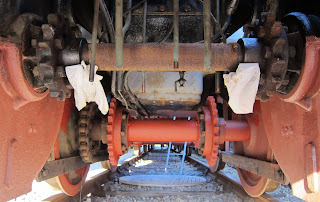His concern was that, with two engines, if they were not coupled together so that each chuffed up their respective chimneys at the same time, instead of air being drawn up through the fire, would each engine merely suck air back down the other engine's chimney?
To understand the point, a bit more needs to be known about how a double engined loco works. In particular, each engine has its own double chimney mounted immediately above the firebox.
 |
| Twin double chimneys |
 |
| Plan view of boiler showing the twin double chimneys |
 |
| Single exhaust pipe divides to feed two chimneys |
This all works fine if both engines chuff at the same time; however, if they don't then air can be drawn down the un-chuffed chimney instead of up through the fire (probably being the path of least resistance). The result would be a poorer fire in times of need.
So are 7109's two engines chuff-synchronised?
I had originally thought this was true and that the two engines on 7109 were gear locked together.
 |
| A gear case on the end of each engine crankshaft with the larger gear case below |
However; to my surprise, when I first undid the oil filler cap in the front engine's off side gear case (the one to the right in the photo), I found that the gear case was empty. On the near side, the rear engine's case was also empty.
At first, I thought we'd been diddled but then it dawned on me. There is a sprocket for a chain to drive the front axle from each lower gear; the two gears are not linked and rotate on a fixed, 'dead' axle. Thus the engines rely on the chains being set appropriately and tightly enough to achieve chuff-synchronisation.
 |
| Twin sprockets for chain drive to front axle |
This situation evolved in later double geared locos such as Sentinel 9622.
 |
| Sentinel 9622's drive chains |
To make the double gearing work, both engines are locked together at the end of the crankshaft where the gear is engaged. This happens by having a gear in each upper casing meshed with the gear in the lower casing.
However, there is still more to the picture: double geared engines have a neutral setting in which neither high nor low gear is engaged and the engines can be run with neither load nor locking together. This enables better warming through of the cylinders prior to loco movement.
 |
| Front view showing different sized gears at each side (Diagram derived from 1930 A2 drawing, courtesy Richard Nixon) |
 |
| Side view of upper and lower gear casings (Diagram derived from 1930 A2 drawing, courtesy Richard Nixon) |
So Sentinel 7109, 9622 and other double engined locos have the same problem.
There is yet another consideration and that is to do with the resonant frequency of the chimney system. This may not be relevant if the chuffing frequency never gets high enough to reach resonance and I am sticking my neck out here due to lack of in-depth knowledge of this type of system. (Ask a designer of resonant, high-performance, car exhaust systems!).
Below resonance, a chuff up one pair of chimneys could easily pull air down the other pair if out of sync. At resonance, I do not know what happens. Above resonance, the chuffing will be so fast that sucking air back in won't take place and each chimney will behave as if sealed. (I'm assuming that the chimney system behaves like a ported loudspeaker enclosure).
So the conclusion to all this? I think we'd better just try it and hope for the best!
Andy,
ReplyDeletePlease forgive non-engineer query: wouldn't splitting the exhaust pipe prior to the chimney not remove quite an element of the blast force?
This is after the exhausted steam has travelled from the engines back into the cab - possibly loosing some blast gusto on the way?
Just a non-engineer line of thought.
Cheers - Edgar.
Edgar, (forgiven!) the exhaust steam from each engine travels via its own two inch bore pipe which splits to two one inch diameter nozzles.
ReplyDeleteThus the exhaust steam which is still under some pressure is forced through the two relatively small nozzles to create the blast up the chimneys.
Two nozzles of a given diameter may be just right for this loco whereas one larger one might not have worked as well. I seem to recall that nozzles are quite difficult to design and get right and have to have a fair amount of experimentation before the best performance is achieved.
I intend to do a post on the nozzles some time soon (but not on a theoretical basis).